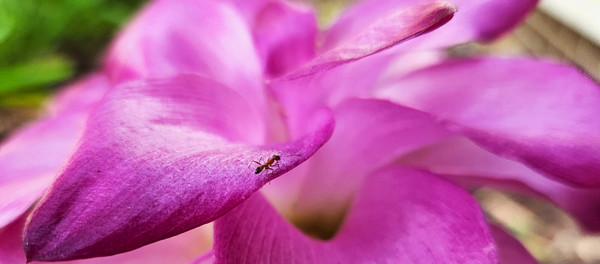Visit
Campus Garden
Bamboo Garden
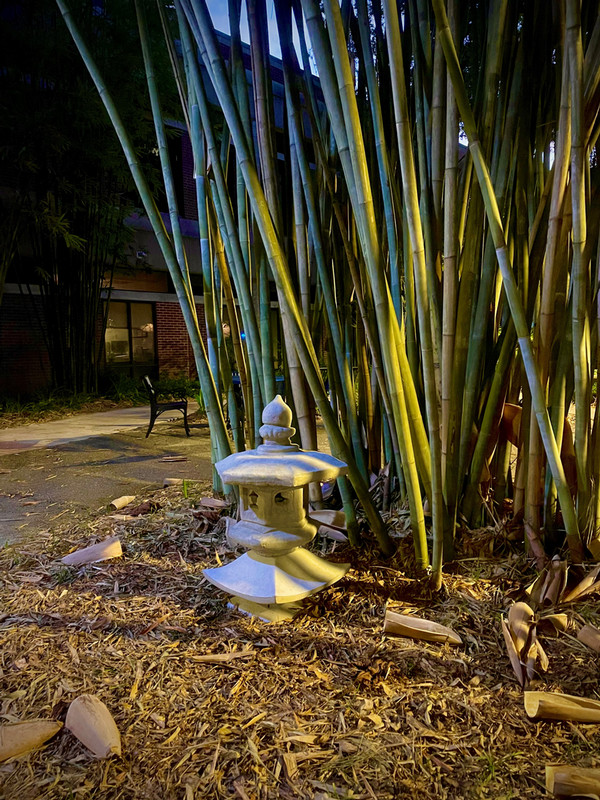
This garden celebrates the beauty and variety of clumping bamboos. Here you can discover the elegance of our bamboo species through texture, shape and even sound.
Though bamboo may look like a tree or a shrub, it is a member of the grass family, Poaceae, with more than 1,000 species worldwide. In addition, it is the fastest growing plant, and some tropical species can grow four feet in just one day! As a result, bamboo is a renewable and sustainable crop used in everything from food, beverages and medicine to construction, paper pulp, fabrics, biofuel and more.
Did you know that bamboo produces 35% more oxygen than trees and consumes more carbon dioxide than any other plant? This means it is helping to reverse the effects of global warming by swallowing up harmful greenhouse gasses.
Cycad Garden
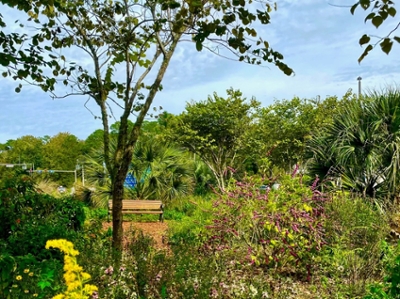
Cycads were once a dominant flora on Earth 300 million years ago and predate dinosaurs. Today, cycads are the most threatened plant group in the world. Botanical garden collections serve as a safeguard against extinction and a resource for research and education.
These living fossils are the oldest seed-bearing plants in the world and are often confused with palms but are not related. Botanically, cycads are closely related to conifers and ginkgos. Cycads are gymnosperms – "naked-seed" plants – that do not make flowers or fruit. Instead, they bear separate female cones that make seeds and male cones that make pollen.
Cycads have a long history of use for food and medicine. While some parts of the plants can be edible when the cycad's poison is removed through cooking, always wear nonabsorbent gloves when handling cycads to avoid accidental poisoning that can have serious results.
Butterfly Garden
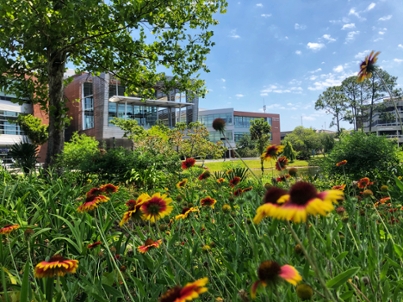
Butterflies have survived on the Earth for over 50 million years and live on every continent except Antarctica. Yet, current ecosystem changes are rapidly reducing their populations.
Most of the plants in this garden produce flowers that attract butterflies. Some, such as milkweed, provide food or shelter for the caterpillars and adult butterflies. Others serve one of the insect’s four life stages: egg, caterpillar (larval), pupa (aka chrysalis), and adult.
Caterpillars are often species-specific in their food preferences. An adult butterfly’s role is to deposit its eggs on preferred host plants. Then emerging caterpillars find leaves that meet their nutritional needs. Caterpillars have voracious appetites and can decimate an entire host plant.
Butterflies are attracted to fragrant pink, purple, orange, yellow and white flowers, with large clusters of small tubular flowers like pentas. These flower clusters serve as bright landing pads, and each floral throat contains an energy-rich nectar food source.
Frederick and Ophelia Tate Ogier Gardens
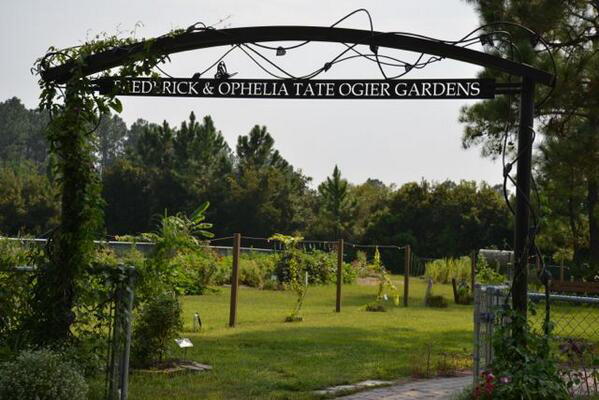
The Frederick and Ophelia Tate Ogier Gardens is the epicenter of innovative environmental and public health programming. Located on one acre, on the north end of campus, these organic gardens feature row crops, a wide variety of fruit trees, raised vegetable beds, and peaceful sitting areas for students to relax.
The mission of the UNF Ogier Gardens is to create a healthier UNF community through nature contact while growing crops and social connections, demonstrating sustainability and biodiversity, as well as nourishing people with local, fresh, and delicious food. Most of the produce grown in the Ogier Gardens is distributed through our on-campus food pantry, the Lend-A-Wing. This addresses student food insecurity by providing fresh produce. Produce is also used for cooking workshops and demonstrations to strengthen our student's healthy life skills.
The Ogier Gardens' programs educate about nutrition, as well as the linkages between environmental, mental, and public health. Through the "Healthy Osprey Initiative," Recreation and Wellness champions a healthy lifestyle and improves student retention.
Peace Plaza Garden
The idea of creating a peace garden was conceived in 2006 when the Gandhi Memorial Society gifted the 8-foot-tall Mahatma Gandhi sculpture to the University. In 2012, UNF became the first campus in Florida to unveil a bronze statue of Martin Luther King Jr., which stands at 8-foot-6-inches tall on the opposite end of Peace Plaza facing Gandhi. Both sculptures were created by artist Jasu Shilpi.
Both peacekeepers quoted Henry David Thoreau and his essay on Civil Disobedience. To highlight his influence, a solid black granite monument - Thoreau's Table – was placed in the garden to feature some of these quotes. The rest of the plaza landscape provides a quiet space for contemplation, meditation or study.
The plaza's eye-pleasing, low maintenance, and water-wise garden flora feature several plants symbolic of peace in many cultures, such as an olive tree, Nelson Mandela Gold bird-of-paradise, bleeding heart, peace lily, sedums and rosemary.
Climate Change Demonstration Garden
The garden was grown to represent how the impacts of climate change might alter our traditional local landscaping. While our local plant hardiness zone is 9a, some of the flora in this site are from warmer zones with a 10 degree difference or higher.
This site provides a localized micro-climate through a combination of concrete sidewalks and south-facing brick walls, which absorb heat from the sun throughout the day. Then heat is slowly released during the night when temperatures drop.
Though some of the plants are from warmer zones, these plantings do not receive any additional protections during the winter, most surviving year to year apart from extreme cold events. The coexistence of plants from various zones shows how adaptable our local plants are, the changes made by our warming climate and what landscaping options work.
Bioswale Garden
The bioswale garden was designed to resolve localized flooding issues and to slow and clean stormwater runoff from the road. This technique provides an attractive, more ecologically minded landscape than traditional storm drain systems. A bioswale is a channel backfilled with porous materials and vegetation to increase groundwater recharge and reduce stormwater runoff.
This garden eliminates thousands of gallons of stormwater runoff annually by approximately 31%. Plants and gravel act as filters and remove pollutants from stormwater, so the water is cleaned before it reaches nearby waterways and aquifers. The plants chosen are native to this region, hardy, strong-rooted, and can tolerate wet and dry conditions. Flowering perennials add variety and color, while shrubs and small trees provide height and structure.
A bioswale provides habitats for insects, birds, reptiles, amphibians, and mammals and can be effectively used for home landscapes as well.
Roy Lassiter, Arthur Bloomer and Jack Funkhouser
Leaders and Legends Garden
The garden was founded in 2022 to honor Founding Faculty members Roy Lassiter, Arthur Bloomer and Jack Funkhouser. This modern outdoor remembrance celebrates their enduring friendship, love of the fine arts, music and contributions to the University of North Florida.
The boxwoods and native dwarf yaupon holly shrubs are pruned into topiary balls and arranged to symbolize music dots and notes. White coquina stone mulch represents sheet paper. Evenly spaced zelkova tree trunks suggest measures of music, and large granite spheres echo the topiary shape and provide a whimsical structural element. The spheres and large planters adorning the half columns are available to dedicate to a loved one.
The movement of wind produces resonance and reverberations as it rustles leaves and engages the wind harp. Musical sounds from plants, nature and instruments are therapeutic and a harmonious way to honor this legendary trio’s leadership that helped to guide the University’s School of Music into a premier program.
Setzer Family Healing Garden
~for mental and physical wellness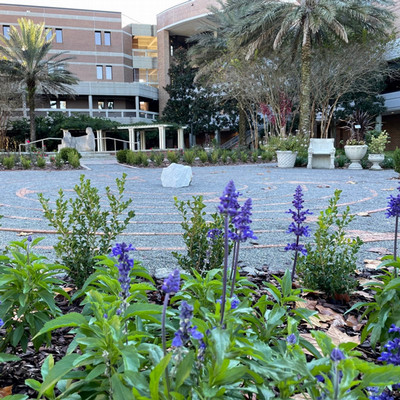
Experience the Therapeutic Nature of the Garden and restore yourself through nature by interacting with calming plants. Choose to move freely through the gardens as you learn about the healing powers of various medicinal plants.
In the Rose Parterre, experience planted geometry, smell a rose and meditate while walking the labyrinth. The artful arrangement of plants and fragrances delights the senses within a controlled setting.
Experience nature at work within the informal Bee Patch. Observe birds and an array of pollinators foraging for nectar and pollen from flowers of different shapes and colors.
Unwind under a ceiling of green and blue and immerse yourself within the urban forest. Rest on a rock or cradle in a hammock while taking a hiatus from the day's stress.
Native Garden
This garden showcases Florida's rich diversity of indigenous trees, shrubs, grasses and wildflowers with the wildlife they support. The plants display their natural habitat relationships and include a beach dune, dry prairie, coastal upland and wetland areas. Understanding plant associations helps us to select the right plant for the right place and group them based on similar needs to help them thrive.
Native plants save water and require no pesticides or fertilizer because they have adapted to our climate and soils over thousands of years, unlike many nonnative plants. They also support wildlife with food and shelter. By selecting Florida-friendly native plants, we help conserve natural resources.
Recent studies have documented an alarming decline in insect populations worldwide due to habitat loss from urbanization. Adding native plants to urban landscapes creates wildlife corridors that can save and reverse this decline.
Potager Permaculture Guild
Guests to this potager garden, nicknamed the “snack trail,” are encouraged to enjoy snacking on seasonal crops such as “ice cream” bananas.
What is a potager garden? Potager is a French word meaning a kitchen garden that includes vegetable plots that are both pretty and productive. Since potager gardens have flowers and decorative elements, adding permaculture land management principles is economical over traditional farming practices.
Permaculture uses 12 ecological practices, such as intermixing companion plantings for increased biodiversity, with huge benefits that include attracting good bugs, repelling harmful bugs, increasing yields and conserving energy. For example, lemongrass intermixed with bananas is a natural deterrent for pests and weeds. Roselle Hibiscus flowers provide pollination with edible rose hips. Sweet potato and spinach double as produce and form a living groundcover that prevents weeds while retaining soil moisture. Beans use banana stalks for support as they grow and are excellent nitrogen fixers.

